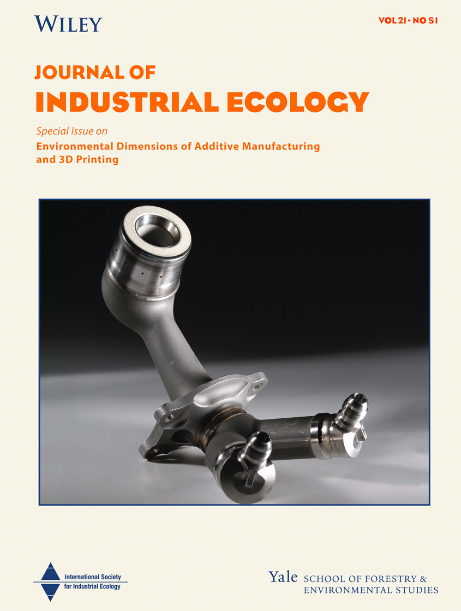A special edition of the “Journal of Industrial Ecology,” a peer-reviewed scientific journal produced by the Center for Industrial Ecology (CIE) at the Yale School of Forestry & Environmental Studies (F&ES), has looked at the environmental, energy and health impacts of additive manufacturing.
Entitled “Environmental Dimensions of Additive Manufacturing and 3D Printing,” the November 2017 issue looks at product life cycles, process energy consumption, sustainability benefits and health and safety considerations in additive manufacturing.
The paper, funded by GE, the Lounsbery Foundation, and the US Department of Energy Office of Energy Efficiency and Renewable Energy, was edited by Reid Lifset, Martin Baumers (University of Nottingham), William Flanagan (AspireSustainability), Tim Gutowski (Massachusetts Institute of Technology), and Joost Duflou and Karel Kellens (KU Leuven).
Understanding the environmental implications of 3D printing
According to Yale’s Kevin Dennehy, although the technological capabilities of additive manufacturing processes have been and continue to be studied extensively, there is still a gap in the understanding of their environmental implications.
Speaking to the F&ES news site, Reid Lifset, the journal’s editor in chief said that “the research in this issue shows that it is too early to label 3D printing as the path to sustainable manufacturing.”
Lifset cited the need for greater knowledge of “material footprints, energy consumption in production, process emissions, and especially the linkages and alignments between the various stages in the production process.”

Research presented in the journal
In his editorial, Lifset notes that 3D printing has been as a source of autonomous environmental improvement, and asserts that most research on 3D printing has focused on the benefits and impacts of production.
Consideration has not been given, however, to waste products such as supports and residual feedstock. There are also potential problems associated with greater volume of production and therefore greater waste. This, he suggests, justifies research into 3D printing and industrial ecology.
Within the journal, articles by Díaz Lantada et al. and Baumers et al. highlight the environmental opportunities presented by additive manufacturing of structures with high geometric complexity, focussing bioprinting and EBM processes respectively.
Extensive analysis of resource consumption patterns in additive manufacturing supply chains is approached by Holmström and Gutowski, while Cerdas et al. highlight the difficulties regulating and measuring 3D printing in private spheres, such as in homes. Mami et al. use a case study from the aeronautical industry to suggest an eco-efficiency method which combines life-cycle costs and life cycle environmental assessment.
Articles in the journal also look at product life cycles. Bours et al. identify the need for new assessment tools for the selection of 3D printing material, while Faludi et al. show that electricity use during 3D printing has, in general, the greatest environmental consequences.
Finally, health and safety considerations in 3D printing are considered in articles by Graff et al, Mendes et al, and Azimi et al. The risks that these articles identify include ultrafine substances produced during material extrusion, fine airborne metallic particles from powder bed fusion, and condensates from chemical processes. The affected range from industrial machine operators to users of desktop 3D printers in office environments.

Implications of the research
The research suggests overall that the environmental performance and sustainability of 3D printing is “very sensitive” to the actual pattern of its usage and configuration of the machinery and materials applied to it.
The recommendations made by the journal editors include more thorough Life Cycle Assessments (LCAs) of 3D printed products, a greater awareness of how specific operating parameters affect environmental assessments, “potential regulatory action” to limit the effects of hazardous emissions, and more innovative eco-design techniques to unlock the full benefits of 3D printing.
The paper also calls for extended tools to monitor the environmental and ecological impact of integration of designs, product personalization, novel materials combinations, and localized production.
“If we are to realize the environmental potential of 3D printing, we need to know where the challenges and the leverage points lie,” summarised F&ES Dean Indy Burke.
The Yale paper follows research published earlier this year by the University of Grenoble on the environmental impact of 3D printing, and a paper produced by King’s College London, which argued that 3D printing was being hindered by a lack of collaboration between molecular scientists and engineers.
“Environmental Dimensions of Additive Manufacturing and 3D Printing,” is published by Wiley-Blackwell and available to read online for free.
Nominations for the second annual 3D Printing Industry Awards are now open. Make your selections now.
For more information on 3D printing and subscribe to our free 3D Printing Industry newsletter, follow us on Twitter, and like us on Facebook.
Featured image shows the library of the Yale School of Forestry & Environmental Studies. Photo via Yale.

